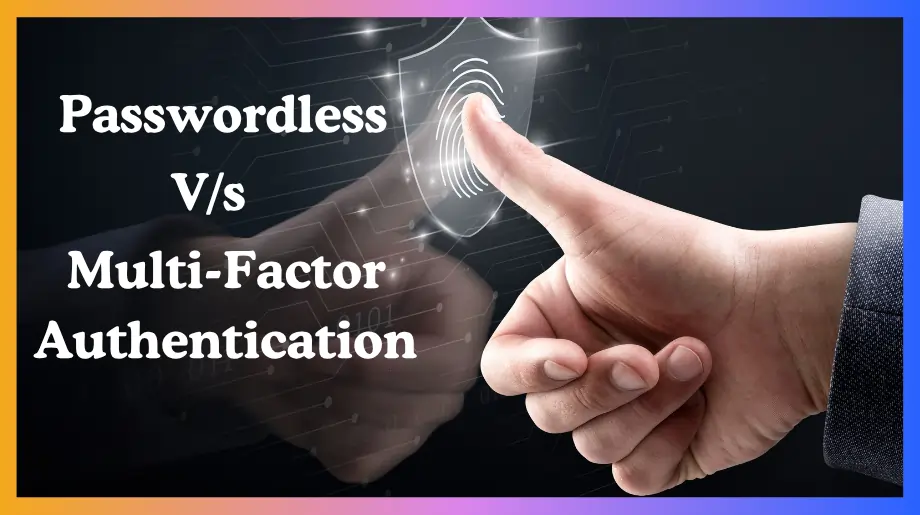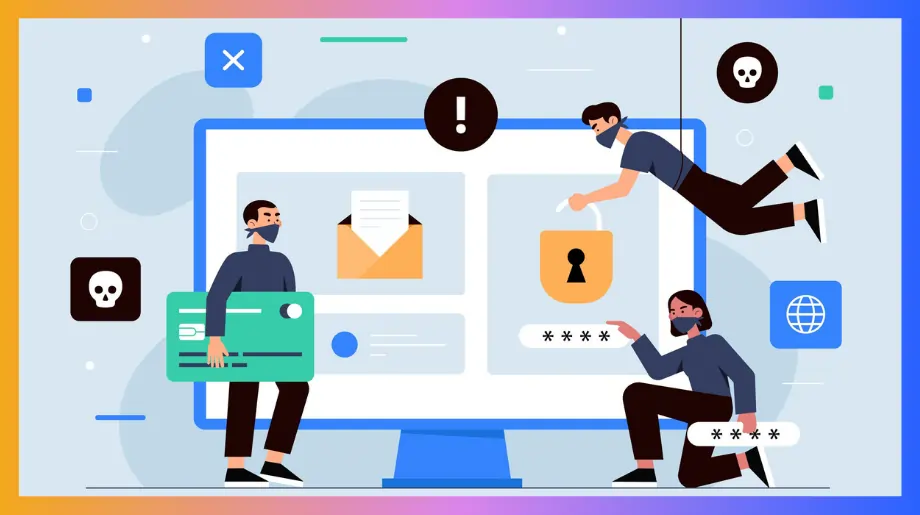Every week, hackers steal 1 million passwords. Companies lose billions fixing security breaches. Users get frustrated with complex login processes that slow them down.
The traditional method of protecting accounts is no longer effective. But two robust solutions are changing how we think about security: passwordless vs mfa.
One eliminates passwords. The other builds stronger walls around them.
Which approach will better protect your business?
Let's find out.
Passwordless Authentication vs MFA: A Detailed Comparison
What Is Passwordless Authentication?
Imagine never typing another password again. No more "password123" or sticky notes on your monitor. That's precisely what passwordless authentication delivers.
Instead of relying on something you can forget, this approach is different. It's innovative. It uses things that are uniquely yours:
- Your biological traits: Your fingerprints are one in 64 billion. Hackers can't steal what's naturally yours.
- Your devices: Your smartphone becomes your secure key. Security tokens provide hardware-based authentication that's nearly impossible to breach.
- Cryptographic methods: Digital certificates work behind the scenes. They act as invisible bodyguards for your identity.
Modern passwordless authentication methods use FIDO2 and WebAuthn technologies. You can't forget your fingerprint, and hackers can't guess your face.
Benefits of Passwordless Authentication
Going passwordless transforms how your business operates:
- Rock-Solid Security: When there's no password to steal, 95% of traditional hacking methods become worthless. This is why passwordless vs mfa debates often favor passwordless for maximum security. Brute force attacks hit brick walls. Phishing attempts fall flat because there's nothing to phish.
- Seamless Experience: Users authenticate in under 3 seconds with fingerprint scans. Compare that to typing complex passwords in 30-45 seconds: no more forgotten passwords or frustrating resets.
- Dramatic Savings: Organizations see a 50-65% reduction in authentication costs. Password reset tickets, which cost $70 each, virtually disappear.
- Future-Ready: The Future of Cybersecurity Is Passwordless. Over one-third of organizations plan to adopt in the next 1-3 years, positioning early adopters ahead of their competitors.
What Is MFA (Multi-Factor Authentication)?
When you access your bank account online, you enter your password and then receive a verification code on your phone. This two-step verification process demonstrates MFA in practical use.
Multi-factor authentication enhances security by requiring verification through multiple independent methods. Instead of relying solely on passwords, MFA combines various types of credentials to verify your identity using different MFA authentication methods.
The authentication process utilizes three distinct categories:
- Knowledge factors: Information only you should possess, such as passwords, PINs, or security questions.
- Possession factors: Physical items you control, including smartphones for receiving codes, hardware tokens, or smart cards.
- Inherent factors: Unique biological characteristics like fingerprints, facial recognition, or voice patterns.
Most MFA systems require at least two of these factors. They must be present together. This layered security approach ensures protection. Even if one credential becomes compromised, unauthorized access remains prevented. The additional authentication elements are still required.
Benefits of MFA Authentication
Organizations implementing MFA in cybersecurity gain substantial security improvements while maintaining operational efficiency:
- Enhanced Security Posture: MFA creates multiple authentication barriers. Attackers must overcome them to gain access. Even with stolen passwords, unauthorized users cannot access accounts. They need additional verification factors. These include your mobile device or biometric data.
- Gradual Implementation: You can deploy MFA strategically across your organization. Start with critical systems and high-value accounts. Then expand coverage gradually. Use proven MFA software solutions. These integrate with existing infrastructure.
- Broad System Integration: MFA works seamlessly with most modern applications and legacy systems. From email platforms to enterprise software, implementation typically requires minimal changes to existing workflows.
- Proven Effectiveness: MFA has consistently demonstrated results across various industries and threat scenarios. Organizations report significant reductions in successful cyberattacks when they implement comprehensive multi-factor authentication strategies.
Key Differences Between Passwordless Authentication and MFA
Authentication Model
The fundamental difference lies in how each approach handles user verification. Passwordless authentication vs MFA represents two distinct authentication models:
Passwordless Authentication Models:
- Biometric Authentication: Uses fingerprints, face scans, or voice recognition to verify users
- Device-Based Authentication: Uses security keys, smart cards, or trusted mobile devices
- Certificate-Based Authentication: Uses digital certificates for secure identity verification
Passwordless authentication eliminates the need for a password. Users authenticate using passwordless authentication methods, such as biometric authentication or hardware tokens, creating a truly password-free experience.
MFA Authentication Models:
- Something You Know + Something You Have: Password plus phone for SMS codes
- Something You Know + Something You Are: Password plus fingerprint or face scan
- Multi-Layer Protection: Combines passwords with multiple verification steps
MFA keeps passwords but adds additional verification steps. Users still enter their credentials and then provide secondary authentication through apps, texts, or biometric scans.
Security Strength
When it comes to security, both approaches significantly outperform traditional password-only systems, but they achieve this in different ways:
- Passwordless Security: By eliminating passwords, passwordless authentication removes the primary attack vector. Cybercriminals exploit this vector most. There's nothing to phish. No credentials to stuff. No passwords to crack. This approach is inherently phishing-resistant.
- MFA Security: MFA creates multiple layers of protection against attackers. Even if they compromise your password, they still need to bypass additional authentication factors. However, MFA systems can still be vulnerable to sophisticated phishing. They're also vulnerable to man-in-the-middle attacks. This particularly affects those using SMS or email-based codes.
User Experience and Adoption
User experience often determines the success or failure of any authentication system:
- Passwordless Experience: Users enjoy faster, more intuitive login processes. A quick biometric scan or QR code login takes seconds and feels natural. There's no cognitive load from remembering passwords.
- MFA Experience: While more secure than password-only systems, MFA can create friction for users. Users must complete multiple steps, which can be time-consuming and frustrating, especially when codes expire quickly or devices aren't immediately available.
Total Cost of Ownership (TCO)
The financial impact of your authentication choice extends beyond initial licensing costs:
- Passwordless TCO: When organizations switch to a passwordless system, the initial cost is higher. But over time, they save money. There are fewer password reset requests and security incidents. IT teams spend less time on support. Employees work more efficiently. Thanks to these benefits, companies usually recover their investment within 18 to 24 months.
- MFA TCO: You're looking at smaller upfront costs. But here's the reality - those operational expenses keep coming. While MFA does reduce security incidents, it won't magically eliminate all password reset calls. Organizations continue to struggle with password management headaches. 30% of IT help desk tickets remain password-related.
Ease of Implementation & Integrations
Implementation complexity varies significantly between approaches:
- Passwordless Implementation: Requires more careful planning and potentially new hardware (biometric scanners, security keys). However, modern solutions offer APIs and SDKs that simplify integration with existing systems.
- MFA Implementation: Generally easier to implement initially, especially with software-based solutions. Many MFA systems can be deployed by simply asking users to download an authenticator app.
Compliance and Regulatory Alignment
Compliance and Regulatory Alignment Rules are changing to require better login methods:
- Passwordless Compliance: Government rules today require basic security. But passwordless login provides an extra layer of strong security. This gets you ready for future stricter rules. Many government regulations now recommend passwordless login. It's the most secure and reliable method for accessing systems.
- MFA Compliance: Meets today's government rules for most types of businesses. However, government rules may change and become stricter. Companies may need to enhance and strengthen their MFA systems.
Threat Protection and Risk Mitigation
Both approaches excel at protecting against different types of threats:
- Passwordless Threat Protection: Completely stops password-based attacks from happening. Good at stopping phishing, credential stuffing, and brute force attacks. The best passwordless systems also defend against more advanced attacks. These include man-in-the-middle attacks.
- MFA Threat Protection: It makes it much harder for attackers to succeed. It puts up multiple walls they have to break through. However, clever attackers can still bypass MFA. They use advanced phishing techniques or SIM-swapping attacks.
Scalability and Long-Term Strategy
Consider how each approach scales with your organization's growth:
- Passwordless Scalability: Ideal for large companies after installation. You don't need to help people reset passwords. Your IT team saves a lot of time. The bigger your company gets, the more time you save.
- MFA Scalability: This can grow with your company. But it becomes harder to manage with more people. You need to keep track of different login methods. This applies to various types of workers. It requires increasing effort as your organization grows.
When to Choose MFA vs Passwordless
The decision between MFA vs passwordless depends on your organization's specific circumstances:
Choose MFA When:
- You need to improve security quickly without significant changes to your current systems. MFA can be set up within weeks. It works with most existing technology. This makes it perfect for urgent security improvements when you can't afford system downtime.
- Your budget is limited for upfront technology investment. MFA solutions cost 60-70% less at the start compared to passwordless systems. This makes them ideal for companies with tight budgets that still require robust security.
- You have older systems that may not work with passwordless technology. Many companies still use systems built 10-15 years ago. These weren't created for modern login methods.
- You want to test new login methods before entirely switching to passwordless. Starting with MFA helps your team learn how users behave. It enables you to spot potential problems before making bigger changes. This reduces the risk of costly mistakes.
- Your current MFA setup already meets industry rules. If you're already following required standards like HIPAA or PCI DSS, there may be no immediate need to upgrade. This allows you to use your resources on other priorities.
Choose Passwordless When:
- User experience is crucial: Passwordless authentication reduces login time by 40%. It eliminates password-related frustration. This can drive customers away. It directly impacts your revenue and customer satisfaction.
- You are building new systems or going through digital transformation: New implementations are perfect timing. You can adopt passwordless technology easily. No complications of legacy system integration. You're getting it right from the start.
- Long-term cost savings are your primary concern: Initial costs are higher. But passwordless systems reduce IT support costs by 50%. They eliminate password-related help desk tickets. This results in annual savings of thousands of dollars.
- Your organization handles highly sensitive data: Maximum security is required. Passwordless authentication provides 99.9% protection against phishing attacks. Traditional MFA offers 60-80% protection. This could mean the difference between staying secure and facing a costly breach.
- You want to prepare for future technology changes: Industry experts predict passwordless will become standard within 3-5 years. Investing now means no expensive upgrade later.
Consider a Hybrid Strategy: Many organizations begin with MFA first. This helps users become familiar with advanced authentication. Then they gradually move to passwordless methods over 12-18 months. This approach enables smooth change management. It builds toward optimal security without overwhelming users or IT teams. This provides the best of both worlds.
Modernize MFA and Passwordless with Infisign
Choosing between passwordless vs MFA doesn't have to be hard. Infisign gives you both options in one simple platform. You can start with MFA today and move to passwordless later.
Infisign's platform is built for security. It combines multi-factor authentication with passwordless authentication methods in one place. You get the best of both worlds without the hassle.
Why Companies Pick Infisign?
- Easy Authentication Options: Start with MFA using fingerprints or phone codes. Then switch to passwordless when you're ready. Everything works in one platform.
- Strong Security: Infisign stops 99.9% of phishing attacks. The platform works with 6000+ apps and tools you already use. No compatibility problems.
- Smart Automation: Infisign's AI helps manage who gets access to what. It cuts IT work by 50%. You can approve requests right from Slack or Teams.
- Save Money: Infisign's pricing is clear and simple. You save 50-65% on login costs. Most companies see returns in 18-24 months.
- Future-Ready: Meet today's rules and prepare for tomorrow's. Infisign keeps logs automatically. Works with cloud and on-site systems.
Start Securing Your Business Today
Don't let weak passwords put your company at risk. Whether you want to remove passwords completely or make your current system stronger, Infisign helps you get there.
Ready to eliminate passwords and strengthen your security? Experience the future of authentication with Infisign's advanced MFA and passwordless solutions.
FAQs
What is the difference between passwordless and MFA?
The big difference is that passwordless means you don't need to remember any passwords at all. You simply use your finger or face to log in to your accounts. MFA means you still need to type your password first, and then you have to do one more thing, such as getting a code on your phone or using your fingerprint.
It's like this: passwordless is like using only your face or finger to open a door. MFA is like using a key first, then also showing your ID card to get inside.
Is passwordless safer than 2FA?
Yes, passwordless is safer than 2FA because it eliminates the need for passwords. With 2FA, you still need to type your password first and then complete an additional step, such as receiving a code on your phone. Hackers can still trick you into giving them your password. But with passwordless, there's no password for them to steal! You simply use your finger or face, and hackers can't easily copy those.
What is the difference between MFA and passkey?
MFA is a security system that requires multiple steps. It verifies your identity in stages. You need your password first. Then you complete additional verification. This includes receiving a code on your phone. Or using your fingerprint.
Passkeys are an advanced authentication technology. They eliminate passwords completely. They use only your biometric data (such as face or fingerprint) or secure devices to verify your identity. MFA still relies on passwords plus extra verification steps. But passkeys completely remove passwords. They use only safe, device-based authentication methods.






















